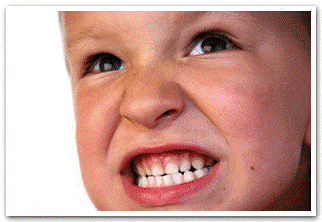It may sound like a screeching and grinding, and it is as unnerving as scraping your fingernails across a blackboard. You may hear these types of sounds from your sleeping child’s bedroom, and you don’t know what it is. Bruxism, or teeth grinding, is a common habit among children, in particular for those under age 11. It is often considered to be a normal behavior. But dentists and doctors don’t always agree on the best treatment for bruxism. This is because the causes of this condition are not yet fully understood. It is believed that psychological stress plays a significant role in bruxism.
Bruxism can manifest during the day and the night
The bruxism word comes from the Greek “brycheim” from which “ebryxa” is derived, to gnash the teeth. The first time it was used was in 1931 to describe excessive, involuntary clenching, grinding or rubbing teeth together. Recently, this condition has been further researched and as a result, it was defined as a nocturnal (at night) and diurnal (during the day) parafunctional activity. Bruxism refers to the movements of the jaw and teeth that are not necessary for functional activity (speaking, chewing, swallowing, a.o.). Any repetitive parafunctional forces are able to damage the teeth.
Children are the ones to suffer from various habits that are conducted without consciousness, like cheek and nail biting. These manifest just like grinding and/or clenching of the teeth, they manifest without awareness, mostly during intense concentration or stressful situations. When the child is made aware of it, then the bruxism may stop or modify. But it is impossible to stop bruxism consciously while being asleep.
Many theories
Healthy infants may manifest bruxism from around one year of age after the front teeth came into the mouth. Young children may experience teeth grinding due to the immaturity of the neuromuscular system that is in charge of chewing.
Researchers think that bruxism is part of the arousal response, which is defined as the sudden change from deeper to lighter sleep. More than 80% of sleep bruxism episodes happen to young adults during periods as stages one and two non-rapid-eye-movement (REM) sleep and just 5-10% during the deep sleep stages. Most of the episodes lead to a sudden shift of sleep stage, toward lighter sleep and awakening.
Medication and lifestyle habits may trigger grinding
There are medications, like most prescribed antidepressants, that contribute to grinding habits. And in today’s age more and more children are taking this type of drug, so if your child is taking antidepressants, you should consider it as a factor when treating bruxism. Hyperactivity is another associated condition to children suffering from bruxism. Amphetamines used to manage ADHD (attention deficit hyperactivity disorder) are also possible factors that trigger for bruxism.
Older teens may suffer from bruxism as a result from lifestyle habits, such as smoking, alcohol drinking, drug use, trauma, disease or from different medication. Conditions such as cerebral palsy, epilepsy and Down syndrome can also cause bruxism.
In the second part of the article you will learn about the other causes of bruxism and about how to treat it.

